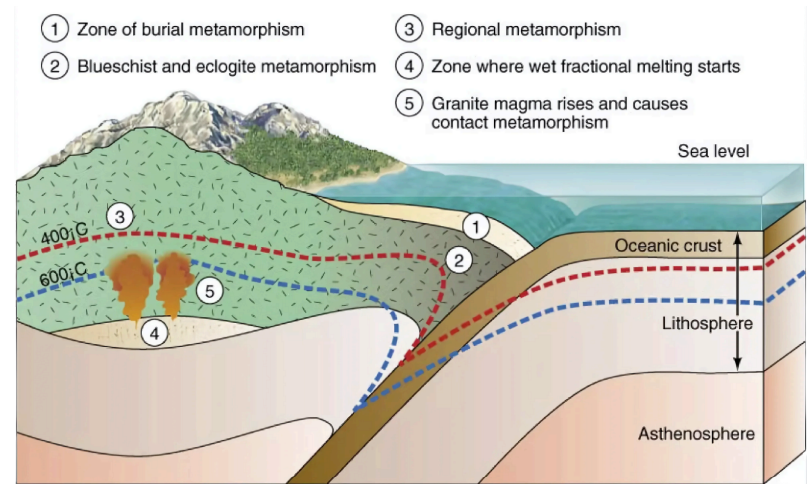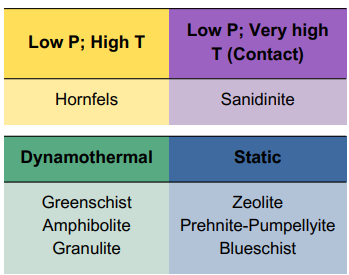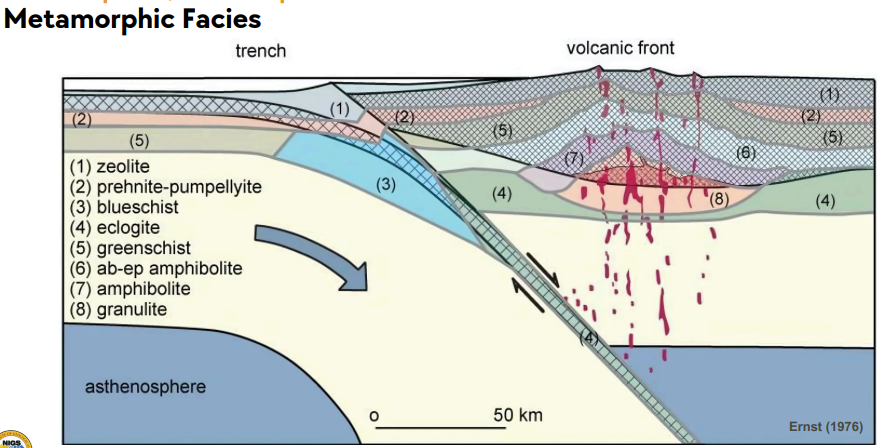Lecture 8: Metamorphism
Metamorphism
Transformation of the mineralogy, texture, and sometimes chemical composition of a parent rock (protolith)
Process of change undergone by an existing rock (protolith) in solid-state (<5% melting or anatexis) to another rock
Lower limit: Diagenesis — sedimentary process
Upper limit: Melting — igneous process

Types of Metamorphism:
Zone of burial metamorphism
Blueschist and eclogite metamorphism
Regional metamorphism
Zone where wet fractional melting starts
Granite magma rises and causes contact metamorphism

Protolith
Parent rock, represents the rock from which metamorphic rock was derived
May be igneous, sedimentary, or metamorphic in origin
The chemical composition of the protolith determines the degree of change (isochemical vs. allochemical) imposed by a metamorphic agent
Examples:
Shale —> Slate
Granodiorite —> Folded gneiss
Metamorphism Agents
Heat
Provides energy that drives chemical reactions to proceed and result to recrystallization of existing minerals
Recrystallization - formation of new or enlarged crystals at the expense of pre-existing mineral grains
Example: Limestone —> Marble
Sources of heat:
Geothermal gradient
Magmatic bodies
Radioactive decay
Pressure
provides energy that compacts and drives chemical reactions to proceed and result to recrystallization of existing minerals and may also result to the reorientation of the linear to platy minerals to a preferred direction
Lithostatic / Confining Pressure
pressure from overburden with equal stress applied from all directions causing further compaction and phase change producing denser polymorphs of pre-existing minerals
Example of polymorphs:
Kyanite - high pressure variety of aluminosilicate subgroup
Sillimanite - high temp variety of aluminosilicate subgroup
Andalusite - low temp and pressure variety
Compressional / Differential Pressure
unequal pressure in different directions wherein rocks subjected to compressional stress are shortened parallel to the direction of maximum stress and elongated in the perpendicular direction
Chemically Active fluids
dissolve and transport ions within the rock facilitating recrystallization and sometimes, when source from a different material, exchange ions between the hydrothermal fluids and the rock
Hydrothermal Solution
hot and ion-rich fluids that are expelled from a magmatic body as it cools and solidifies
Metasomatism
exchange of ions between the invading hydrothermal fluid and the compositionally different host rocks changing the overall chemical composition of the rocks
The seafloor is highly metamorphosed
Fluid types:
Connate water - fluids in pore spaces of original rock / sediments
Liberated water from hydroxides - fluids from dehydrated mineral (phlogopite, amphibole)
Juvenile - fluids from magma
Metamorphism Types
Based on rock area / volume affected
Local Metamorphism
driven by small-scale processes (e.g. intrusions, faults) and are this limited to a small volume (<300 km³)
Regional Metamorphism
generated by large-scale processes typically associated with orogenesis (mountain building)
Example:
Pillow lavas - exhibit serpentinization, when mafic/ultramafic is metamorphosed to serpentinites
Based on nature of chemical affected
Isochemical metamorphism
No new elements are introduced into the system
The relative concentrations of previously present elements remain constant throughout the metamorphic process
Involves textual change (recrystallization and compression)
Example:
Contact - marble, quartzite
Dynamic Metamorphism - fault breccia, mylonite
Allochemical metamorphism
Integrates elements introduced into the system during the reaction process into the newly formed mineral species
Involves chemical change (metasomatism) and formation of new minerals
Example: Hydrothermal metamorphism - basalt —> serpentinite
Based on dominant agent of metamorphism
Contact / thermal metamorphism
Dominant T; low P
Magma invading pre-existing rock creates an aureole around the intrusion
Aureole
zones of alteration wherein the metamorphic grade is controlled by the distance from the intrusion
Creates non-foliated metamorphic rocks
Bake-and-chill margins
textural contrast between an intrusion and the country rock caused by contact metamorphism
clear boundary where crystallization happens
Dynamic Metamorphism
Dominant P (deviatoric stress)
Rocks are subjected to shear forces along the shear zone
Brittle Deformation - occurs at shallow depth and low geothermal temperature
Fault breccia - loosely coherent rock from pulverized rock
Ductile Deformation - occurs at great depth with higher temperatures
Mylonite - apparently foliated; formed from intense ductile deformation
Burial / static metamorphism
Dominant P
Massive amount of materials accumulating in a subsiding basin induces low-grade metamorphism in the deepest layers
Associated with subduction zones
Dynamothermal / regional metamorphism
Dominant T and P (high grade)
Occurs during orogenesis where large segments of the crust are subjected to high T and P conditions
Associated with collision zones
They would create folded or compositional banded rocks (like gneiss)
Hydrothermal metamorphism
Dominated by chemically active fluids
Hot, ion-rich fluids circulating through fissures and cracks in rocks associated with the emplacement of magma
Can also occur at shallow crustal depths in regions where geysers and hot springs are active
Impact / shock metamorphism
Very high P and T in a short span of time
Produces impactites (rich in shock qtz)
Energy from impacting meteorite converted into heat and shockwaves melting, pulverizing, and shattering the surrounding rocks
Metamorphic Rock Textures
Foliation
Planar arrangement of mineral grains or crystals formed from the directed compression that shorten rocks. This causes flattening or reorientation of pre-existing mineral grains as well as compositional banding
Flattening of spherically-shaped grains along the maximum stress direction
Rotation of platy minerals perpendicular to the maximum stress direction
Recrystallization of new minerals perpendicular to the maximum stress direction
Foliated Metamorphic Rocks
Rock / slaty cleavage
Rocks split into thin planar slabs across the bedding surfaces
Occurs in slates and phyllites (but also occur in higher grade foliated schists and gneisses)
Prominent in low-grade metamorphism of shales
Schistosity
Planar and layered structures from the parallel alignment of platy minerals (msc, bt) that have been recrystallized from minute mica and chlorite flakes to discernable size due to higher T-P conditions
Intermediate-grade metamorphism
Prominent in schists
look like crumpled paper of rocks
Examples:
Talc schist
Garnet mica schist
Blueschist
Mica schist
Gneissic / Compositional Banding
Segregation of dark (bt, amp) and light (qtz, fsp) minerals caused by ion migration due to P-T conditions
High-grade metamorphism
Prominent in gneiss
Non-Foliated
Does not exhibit layered or banded appearance that may be either due to minimal deformation, dominance of equidimensional crystals and absence of platy minerals
Occurs in contact and hydrothermal metamorphism
Granoblastic
exhibit coarse-grained, equant and equigranular crystals with boundaries that intersect at 120° triple junctions
Hornfelsic
exhibit fine-grained (<1 mm), irregular and interlocking grains in a non-foliated fabric that forms from contact metamorphism of fine-grained protolith
Metamorphic rocks exhibiting bimodal size distribution
Porphyroclastic
contain porphyroclasts that can reveal the direction of shear
Porphyroclast
large relic grains from protolith, from before cataclasis, that have experienced deformation but retained its original composition
Augen - oval-shaped fsp porphyroclasts
Flaser - oval-shaped qtz porphyroclasts
Porphyroblastic
contain porphyroblasts that reveal local tectonic and metamorphic evolution
Porphyroblast
large crystals that experienced neocrystallization and growth in response to the new P-T conditions that typically develop crystal faces
Examples:
Garnet mica schist
Pinite hornfels
Staurolite schist (iron cross)
Porphyroblast is called idiomorphic when it is well-formed, sub-idiomorphic when partly well-formed, and allotriomorphic when it is not well-formed
Metamorphic Rock Classification
Metamorphic rocks are typically classified by their:
Texture - size, shape and relationships of constituent minerals
Protolith - metamorphic rock retains characteristics of protolith
Mineralogy - abundance of mineral phases present

Metamorphic Grade
Describes the relative T-P conditions under which metamorphic rocks form
Low Grade
Temperature: 200 - 400°C
Pressure: 1 - 6 kbars
High Grade
Temperature: 500 - 1000°C
Pressure: 12 - 40 kbars
Prograde
Mineralogy reflects lower P-T to higher P-T transformation
Retrograde
Mineralogy reflects higher P-T to lower P-T transformation
Index minerals
used to distinguish among different zones of regional metamorphism
Metamorphic Facies
Set of rocks representing the full range of possible chemistries within a limited range of metamorphic conditions



Example: Metamorphism at 3.5 kbar and 300°C
Marble (limestone): calcite, dolomite, and minor quartz
Metabasalt (basalt): chlorite, albite, actinolite, epidote, and minor quartz
Pelitic schist (mudstone): quartz, chlorite, muscovite, and albite
Different mineralogically (because of the protolith) but metamorphosed under the same conditions and thus represents the same region (facies)
Resources from Metamorphic Rocks
Metals from hydrothermal deposits
Includes economically important minerals such as copper, gold, molybdenum, silver and zinc
Metasomatism causes mobility of metal ions which subsequently concentrates within faults and fractures
Marble
Formed from contact metamorphism of limestones, used primarily in construction (e.g. cement, tiles)
Asbestos
Formed from hydrothermal metamorphism of ultramafic rocks, used for insulation and fireproofing
Metamorphic Rocks in the Philippines
Schist - foliated and metamorphosed volcanics (Suyo Schist in Burgos, Ilocos Norte and Alicia Schist in Bohol)
Amphibolite - composed of foliated amphiboles and plagioclases; protoliths; gabbros and diorites (Dalrymple Amphibolite in Palawan)
Serpentinite - composed of serpentine as a product of hydrothermally altered peridotites (Sibuyan Ophiolitic Complex)
Marble - metamorphosed limestones (Romblon Metamorphic Complex - Romblon Marble)